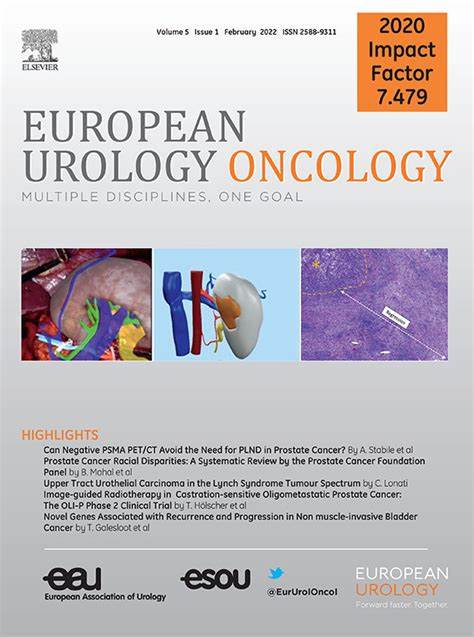Functional Outcomes and Quality of Life in High-risk Prostate Cancer Patients Treated by Robot-assisted Radical Prostatectomy with or Without Adjuvant Treatments
IF 8.3
1区 医学
Q1 ONCOLOGY
引用次数: 0
Abstract
Background
Robot-assisted laparoscopic prostatectomy (RALP) is used frequently to treat prostate cancer; yet, prospective data on the quality of life and functional outcomes are lacking.
Objective
To assess the quality of life and functional outcomes after radical prostatectomy in different risk groups with or without adjuvant treatments.
Design, setting, and participants
The Be-RALP database is a prospective multicentre database that covers 9235 RALP cases from 2009 until 2016. Of these 9235 patients, 2336 high-risk prostate cancer patients were matched with low/intermediate-risk prostate cancer patients.
Intervention
Patients were treated with RALP only or followed by radiotherapy and/or hormone treatment.
Outcome measurements and statistical analysis
We used a mixed-model analysis to longitudinally analyse quality of life, urinary function, and erectile function between risk groups with or without additional treatments.
Results and limitations
Risk group was not significant in predicting quality of life, erectile function, or urinary function after RALP. Postoperative treatment (hormone and/or radiotherapy treatment) was significant in predicting International Index of Erectile Function (IIEF-5), sexual activity, and sexual functioning.
Conclusions
Risk group was not linked with clinically relevant declines in functional outcomes after RALP. The observed functional outcomes and quality of life are in favour of considering RALP for high-risk prostate cancer. Postoperative treatment resulted in lower erectile function measures without clinically relevant changes in quality of life and urinary functions. Hormone therapy seems to have the most prominent negative effects on these outcomes.
Patient summary
This study investigated the quality of life, and urinary and erectile function in patients with aggressive and less aggressive prostate cancer after surgery only or in combination with hormones or radiation. We found that quality of life recovers completely, while erectile and urinary function recovers only partially after surgery. Aggressiveness of the disease had a minimal effect on the outcomes; yet, postoperative treatments lowered erectile function further.
接受或不接受辅助治疗的机器人辅助根治性前列腺切除术的高危前列腺癌患者的功能结果和生活质量
背景:机器人辅助腹腔镜前列腺切除术(RALP机器人辅助腹腔镜前列腺切除术(RALP)被频繁用于治疗前列腺癌;然而,有关生活质量和功能预后的前瞻性数据却缺乏:目的:评估不同风险人群在接受或未接受辅助治疗的情况下接受根治性前列腺切除术后的生活质量和功能预后:Be-RALP数据库是一个前瞻性多中心数据库,涵盖2009年至2016年的9235例RALP病例。在这9235例患者中,2336例高风险前列腺癌患者与低/中风险前列腺癌患者进行了配对:结果测量和统计分析:我们采用混合模型分析法,纵向分析了接受或不接受额外治疗的风险组之间的生活质量、泌尿功能和勃起功能:风险组别对 RALP 术后生活质量、勃起功能或排尿功能的预测意义不大。术后治疗(激素和/或放疗治疗)对预测国际勃起功能指数(IIEF-5)、性活动和性功能有显著影响:结论:风险组别与 RALP 术后临床相关的功能结果下降无关。观察到的功能结果和生活质量支持考虑对高风险前列腺癌患者进行 RALP 治疗。术后治疗导致勃起功能降低,但生活质量和泌尿功能没有发生临床相关变化。患者总结:这项研究调查了侵袭性和侵袭性较低的前列腺癌患者在仅接受手术或结合激素或放射治疗后的生活质量、泌尿和勃起功能。我们发现,手术后生活质量完全恢复,而勃起和排尿功能仅部分恢复。疾病的侵袭性对结果的影响微乎其微;然而,术后治疗会进一步降低勃起功能。
本文章由计算机程序翻译,如有差异,请以英文原文为准。
求助全文
约1分钟内获得全文
求助全文
来源期刊

European urology oncology
Multiple-
CiteScore
15.50
自引率
2.40%
发文量
128
审稿时长
20 days
期刊介绍:
Journal Name: European Urology Oncology
Affiliation: Official Journal of the European Association of Urology
Focus:
First official publication of the EAU fully devoted to the study of genitourinary malignancies
Aims to deliver high-quality research
Content:
Includes original articles, opinion piece editorials, and invited reviews
Covers clinical, basic, and translational research
Publication Frequency: Six times a year in electronic format
 求助内容:
求助内容: 应助结果提醒方式:
应助结果提醒方式:


